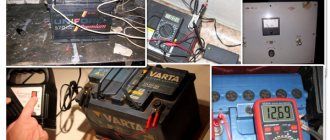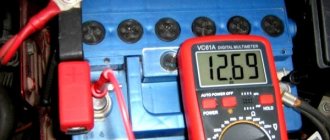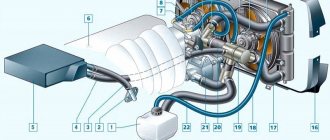car battery
Many novice motorists are concerned about the question of how many amperes can be contained in a fully charged vehicle battery. In order to understand this parameter, you should carefully read the data indicated on the battery itself.
For example, if the battery capacity is 55 Ah, then this car unit can transmit a current of five amperes for eleven hours, provided that the battery is fully charged.
To find out how many amperes there are in a charged battery, you should understand its basic parameters and learn how to calculate everything correctly. Do not think that a capacity of 55 amperes per hour will allow you to deliver a current of 1A for 55 hours, since this is fantastic data.
Battery and its types
So, just as the human body cannot function without a heart, a vehicle cannot start without a part such as a battery. This element is responsible for starting the engine and providing electricity to all consumers that operate when the generator is faulty or the engine is not running . So the importance of this unit cannot be underestimated, and therefore it is necessary to monitor the power of the car battery.
However, there is another very important function, about which a few words should also be said. This is generator support under very heavy loads. It is generally accepted that the battery is charged while the engine is running, so the capacity does not have to be large, since we almost never use electrical appliances without a running motor. But when the “heart” of the car suddenly stalls in the middle of the road, only the starter can move us at least a couple of meters to the side of the road, solely due to the charging current from the battery. This is where capacity becomes important, every amp hour counts.
In general, the design of the battery is quite simple, and there is practically nothing to break in it, but improper operation can lead to deterioration of the battery’s performance. In such cases, important technical indicators inexorably fall, primarily capacity and current power, which means that it will very soon need to be replaced, which will lead to considerable material costs.
Today there are several main types of batteries on the world market. So, they can be dry-charged, i.e. not containing electrolyte, and, on the contrary, filled with this liquid. The main advantages of the former include the possibility of long-term storage, while the properties, and most importantly, the capacity, will not deteriorate one bit. However, this type of battery must be conditioned before use.
Filled ones do not require additional preparation; they are immediately sold in working condition. In addition, in this case you can be sure of the quality of the electrolyte. By the way, these batteries will weigh more due to this liquid. Plus, this type of battery can be checked immediately in the store, but a dry-charged one can only be checked at home, after the unit has been brought into working condition. When purchasing rechargeable batteries, focus on the characteristics and markings, but we will talk about them more specifically below.
This is interesting: What is the volume of oil in the VAZ 2112 engine
How to choose a battery
If you do not want to contact the service or the help of the seller, then the selection algorithm should be as follows.
You need to take a battery that is guaranteed to fit in the niche allocated to it, be it the engine compartment, trunk or something else. Agree: it’s stupid to miss by a couple of centimeters! At the same time, we determine the polarity: we look at the old battery and figure out what is on the right and what is on the left? It goes without saying that if the car is not European, then the terminals themselves may differ from most usual ones - both in shape and in location.
After that, choose a brand. Here we definitely advise you to be guided by the list of our winners of recent years and never “peck” at newcomers or outsiders. Even if their labels are the most beautiful. Here are some of the names that usually did not let us down: Tyumen (Tyumen batteries), Varta, Medalist, a-mega, Mutlu, Topla, “Aktech”, “Beast”.
We conduct comparative tests of various car batteries every year. The latest results where we compared 10 batteries can be seen here. Those interested can also familiarize themselves with the examinations of previous years: 2013, 2012, 2011, 2010, etc.
The brand of the battery usually determines its price. The approximate cost of European car batteries with dimensions 242x175x190 mm in 2014 ranged from 3,000 to 4,800 rubles. for a regular battery, and from 6300 to 7750 rubles. - for AGM. The declared current and capacity will be obtained by themselves - based on the dimensions.
Important: if you had an AGM battery installed, then you should only change it to an AGM battery, and not to a “regular” one. Reverse replacement is quite acceptable, but not economically feasible .
Now we charge the battery - even the one we just bought! Our experience shows: in stores, under the guise of a brand new battery, they happily sell you an “almost new” battery, from which they have barely had time to wipe off the dust. We charge it, connect it instead of the old battery, and the key is ready to go!
How many amperes should I set my car battery to when charging?
Charging the battery
It is worth immediately figuring out how many amperes to set the battery to when charging, so that the car unit does not fail during its further operation. In order to determine the battery charge level, it is worth understanding that when the car battery is fully charged, you need to see a charge of 12.6 volts or higher at the terminals. If it is 12.5 V, then approximately eighty-five percent is discharged, and the battery needs to be charged as soon as possible.
You need to understand that a car battery will not show the maximum number of amperes, since it quickly discharges during operation. When the temperature outside the vehicle interior decreases, the charge will be lost in a 1:1 ratio, which means the voltage will also drop, including due to a cold start.
In order to charge the battery at a certain number of volts and amperes, it is worth understanding the model and charging features of the car battery. According to the technological documentation of most batteries, it is known that when charging you should set:
- voltage twelve volts;
- a current strength of ten percent of the capacity of the car battery itself.
Checking the battery charge using a multimeter
The charge current in amperes will affect the time and quality of the charge, since the reduced current level will make it take much longer to charge the battery. However, if, in pursuit of the speed of charging the car battery, you set the current strength to exceed ten percent, then this will lead to unpleasant consequences, since the electrolyte will simply boil and splash out of the battery cans.
This means that the current strength that will be set for a domestic or foreign battery will directly depend on the voltage and technical characteristics installed at the factory. So, for a battery whose capacity is the classic 60 amperes per hour, the charging current will reach no more than six amperes.
These data will be ideal only at a constant current and voltage level, which means that the owner of a car battery will have to constantly monitor and regulate the strength of the charging current. When the voltage level reaches approximately 14.4 volts, the current should be reduced to three amperes, that is, half.
18650 lithium batteries have their own charging rules:
Charger
- start charging at a voltage of 0.05 volts, gradually raising this parameter to 4.2;
- The current for an 18650 battery can be no more than half or one ampere;
- You should not charge the battery for more than three hours to avoid overheating of the chemical contents.
In order to ideally charge batteries, you must select the correct voltage and current. It will be especially convenient to charge by purchasing a charger with automatic control of the entire process, otherwise you will have to systematically monitor the procedure.
Number of amperes in a charged car battery
The battery capacity is indicated on the battery case or in the operating instructions (passport). Let's look at how to independently check the indicated amps on your battery. Capacity is important for a motorist, since it can be used to find out how much charge the battery will have time to deliver over a certain period of time. The parameter is measured in ampere hours.
Monitoring is carried out under load and without it. The readings are given by a multimeter, and a regular lamp serves as the load. A charged battery should show good performance when the light stays on for a long time, but if it quickly starts to go out, then the battery is faulty. In such testing, we recommend taking a 35–40 W lamp and holding it for about 2 minutes.
A car battery that was charged before measurements and after loading produced a voltage above 12.4 V can be considered serviceable. If the values are reduced, you should consider purchasing a new power source.
Most power sources located in the engine compartment of passenger cars have a capacity of 55–65 Ah. This is quite enough to start the engine in any weather. However, it is worth considering that a car parked in a garage or parking lot gradually consumes current for small needs, for example, a clock on the dashboard, alarm system, central locking, injection controller, etc. If the total volume of consumers does not exceed 50–70 mA, then this will not prove critical. Otherwise, you need to think about reducing current consumption or buying a more powerful battery that can produce more energy.
For those interested in technical details
Is it useful to “warm up” the battery by turning on the headlights before starting the engine in cold weather?
This technique was once actively recommended in the literature. But recent studies have shown that there is no real effect. The car battery still does not have time to heat up, but it loses capacity.
Why do you need a peephole indicator?
This indicator allows you to roughly estimate the density and level of electrolyte to find out whether your car battery needs to be recharged. By and large, this is a toy, since the eye is only in one jar out of six. However, many serious manufacturers at one time were forced to introduce it into the design, since the absence of a peephole was perceived by consumers as a disadvantage.
Is it possible to assess the condition of a car battery by the voltage at the terminals?
It's approximately possible. At room temperature, a fully charged battery, disconnected from loads, should produce at least 12.6–12.7 V.
What is hidden behind the term “calcium battery”?
Nothing special: this is a regular advertising ploy. Yes, the “Ca” (or even “Ca - Ca”) icons on car batteries are increasingly present today, but this does not make them any easier. But calcium is a much less heavy metal than lead. The thing is that we are talking about very small (fractions or units of percent) calcium additions to the alloy from which battery plates are made. If it is added to both positive and negative electrodes, then the same “Ca - Ca” is obtained. All other things being equal, such car batteries are more difficult to boil, which is important for maintenance-free batteries. Such batteries have less self-discharge during storage. Therefore, “ordinary” batteries with additions of previously traditional antimony (they are usually indicated by the presence of plugs) are almost never found on sale today! Note that not everything about them is so bad: for example, they withstand deep discharges much better!
Why do car batteries produce the declared current for such a short time when tested?
Technical characteristics: weight, current, capacity, voltage
So, in order to properly operate this part, you need to know its basic parameters. Thus, one of the most important indicators of a car battery is the capacity, which shows the duration of operation or the amount of electricity supplied. It is usually measured in ampere hours, this makes it possible to weigh how much charge the battery will produce without recharging. The capacity is influenced by many different factors, including the design features of the battery, the temperature of the environment of use, and, of course, the strength of the charging current. If the latter increases, then the capacity decreases, but the influence of temperature is of the opposite nature.
Another parameter that you should pay attention to is the strength of the starting current in the car battery. It corresponds to the value that the battery produces during startup at an ambient temperature of -18 °C. The voltage of a charged battery can also be called a fairly important characteristic. Based on it, you can identify technical problems with the unit or make sure that it is in full working order. If everything is good, the voltage is usually up to 12.6 V, but it can vary slightly, as long as it does not exceed the limit values. The battery voltage also determines the voltage of devices and devices that are now fashionable to connect through the cigarette lighter.
It is important to know that the condition of the battery is negatively affected not only by a low charge level, but also by overcharging. Your electrolyte will boil and the plates will begin to crumble if you do not turn off the device in time to charge. And if you believe the theory, the battery may even explode.
It should be remembered that the normal voltage of the entire car battery is about 12.2 V. Moreover, each bank produces within 2 V. So it is quite possible to check the voltage of the unit with a special load plug. The given figures are valid when the load resistance per each of the cans is determined in accordance with their capacity.
The battery charging power is obtained by multiplying the starting current by the voltage. But such technical parameters are rarely used when discussing this unit. Although if you have to evaluate power, you should keep in mind the operating conditions; even the outside temperature can reduce this characteristic. For example, everyone knows that starting a cold engine requires more current for the starter forces, hence the need for more power. And if your battery is not new, then there may not be enough charge to start the engine, hence numerous problems in winter.
In addition, the overall characteristics and weight of car batteries are also important when purchasing. True, the last parameter may differ slightly from those declared by the manufacturers. And all because of the destruction of lead plates due to their interaction with the electrolyte - these two components mainly determine the large weight of the battery. Therefore, you should not worry if the discrepancy between the indicated and actual weight can reach half a kilogram. This parameter is not as significant for the car as it is for you. If you go to buy a battery not for a car, it is important to calculate that it weighs about 15 kg.
How to find out the charge level of a car battery by its voltage
The simplest method is visual. Today, the degree of charge of the battery can be determined by looking at the hydrometric indicator (as it is called, the “eye”). Thanks to it, the degree of charge of the product is determined without improvised means:
The green color of the indicator indicates that the battery is charged more than 60%; dark color indicates the need to charge the battery; a light color indicates the battery's need for distilled water. You can also roughly determine the performance of the battery using a multimeter by measuring the voltage with the engine off, after leaving it for about 12 hours, as mentioned above. Measurements are carried out at a temperature of +18 C.
Here is a table of car battery charge by voltage:
| Performance level (%) | Voltage (V) |
| 100 | From 12.6 |
| 90 | 12,5 |
| 80 | 12,4 |
| 70 | 12,3 |
| 60 | 12,2 |
| 50 | 12,05 |
| 40 | 11,9 |
| 30 | 11,7 |
| 20 | 11,55 |
| 10 | 11,3 |
| 0 | 10,5 |
A mid-priced battery lasts approximately 3 years. If you follow the operating instructions all this time, the battery will not cause you any trouble. One of the main points here is to avoid deep discharge. After the three-year period, control over the battery should be strengthened: at least once every couple of weeks, measure the voltage of a fully charged battery, and, if possible, the density. After 4–5 years, it is recommended to replace the battery with a new one.
This is interesting: What is the best battery for a car?
Summarizing
Car enthusiasts should know that the battery discharges on its own. This happens if the car is not used for a long time. If you have a new battery installed and you have parked the car, then after 12 months it is not a fact that you will be able to start it. In old batteries this figure is even less - no more than a month.
Therefore, when storing a car for a long time, it is worth visiting it periodically and warming it up - at least once a month. This will not only preserve the battery, but also prevent the oil from emptying in the engine crankcase. After a deep discharge, charging the battery becomes difficult, and in some cases impossible, so if you decide to start the car after a long period of parking, then buy a fresh battery.
Safety rules when charging a car battery.
It is not recommended to charge in a residential area due to the fact that explosive gases are released from the battery. This is true for serviced batteries with plugs.
For the same reason, it is prohibited to smoke or perform any other work with open fire or sparks.
First, the charger is connected to the battery terminals, and then it is connected to the network. Disabling is done in reverse order. First, disconnect the charger (charger) from the network, then disconnect the terminals. This procedure will avoid the formation of a spark when connecting the charger to the battery.
Be sure to unscrew all plugs in batteries being serviced. This can be conveniently done using a regular coin of 2 or 5 rubles. After unscrewing, the plugs must be put back into the holes, but not tightened. This position of the plugs will allow gases to escape freely and at the same time protect the battery from possible dust and dirt getting into it. This will also reduce the loss of electrolyte during evaporation.
The plugs are unscrewed and inserted into their sockets.
Before unscrewing the plugs, be sure to wipe off all dust and dirt from the working surface of the battery. This will also prevent dirt from getting inside the battery.
If the battery is charged in an apartment, then it must be done on a balcony with an open window or in a room where there is an exhaust hood, for example, a toilet.
How should you charge a car battery?
There are two ways to charge the battery. The first of them is relevant if the battery is working and the car can start. To charge you do not need to remove the battery, just drive the engine at high speeds for 10-15 minutes. The main thing is to follow two rules:
- Do not do this in a closed space (for example, a garage or repair bay), otherwise you will suffocate from exhaust gases;
- Do not turn on lighting fixtures.
After all these steps, the battery will gain sufficient charge and will gradually recover if you operate the car for at least several hours in a row. It is advisable to do this during the daytime so as not to create an increased load on the battery with the headlights and interior lighting on.
For the second method, you will need a charger. You need to proceed in the following order:
- Remove the battery from the engine compartment and place it on a flat surface.
- Unscrew the battery caps to allow gas to flow out during charging.
- Cover the holes (loosely) to prevent acid from splashing onto the top of the battery. To do this, you can simply turn the plugs over with the threads facing up and place them in the grooves of the holes.
- Connect the charger to the battery - plus to plus, minus to minus.
- Connect the battery to the network and set the input current equal to 1/10 of the battery capacity (for example, with a volume of 55 A/h, you need to set the indicator to 5.5 Amperes).
- Leave the battery alone until active gas formation begins in all cells. On average, a full charge takes 8-10 hours, but this figure is relative and varies depending on the degree of battery wear, temperature, and other things.
- After disconnecting, do not immediately tighten the plugs; wait at least 20 minutes for the remaining gas to evaporate from the battery capacity.
- Then tighten the plugs and install the battery in the car.
Important: Do not charge a frozen battery, as this may lead to its breakdown, and before charging, check the fluid level in the cells and top up if it is insufficient.
To understand how many amperes there should be when charging a battery, you need to know exactly the battery capacity. Otherwise, charging may be too slow (if you set the value below the required value), or, on the contrary, the batteries will be overcharged, which will negatively affect its resource.
It is also worth being able to determine the state of charge of the battery. This can be done using a multimeter. A car battery provides 100% charge at the terminals of 12.6-12.7 Volts. If the indicator decreases to 12.5, then this means that the charge has dropped by 10-15%. In a regularly driven car, the current power generated by the battery is on average 12.2-12.3 Volts, and this is normal, since the battery in a car is never 100% charged except for those moments when it is removed for recharging or replacement.
How to determine whether a battery is charged or discharged
This can be determined by the voltage at the contacts and the density of the electrolyte.
In a fully charged battery (100% charge), the voltage at the terminals should be 12.7V. When discharged, 11.7V (0% charge). Therefore, every 0.1V is 10% charge. These values are relevant for a battery temperature of 20-25 degrees.
For example, the voltage at the contacts is 12.2V, therefore the charge is 50%.
Table - dependence of the battery charge level on voltage.
The second, more accurate way to determine the degree of charge is by determining the density of the electrolyte. This method is only suitable for serviceable batteries in which it is possible to unscrew the plugs and get to the electrolyte.
A sulfuric acid solution is used as an electrolyte in batteries, the density of which is measured in g/cm3. As the battery discharges, the density of the electrolyte decreases. Knowing this property, you can determine the degree of battery discharge. Density is determined using a special device - a hydrometer.
The density of a fully charged battery (100%) at 25 °C is 1.27-1.28 g/cm3.
The density of a completely discharged battery (0%) at 25 °C is approximately 1.1 g/cm3.
Knowing these data, it can be calculated that approximately every hundredth unit of density is equal to 6% charge (0.01 g/cm3 = 6% charge).
For example, the density is 1.24 g/cm3, therefore the degree of charge is 76%.
Graph showing the dependence of electrolyte density on temperature.
Table - dependence of electrolyte density on temperature.
Before checking the electrolyte density, be sure to turn off the charger and wait a few minutes. Density is more accurately determined when no gas is released from the electrolyte.
Capacity
drive.ru One of the key parameters of any battery, which is measured in ampere-hours (Ah, Ah).
On passenger cars, depending on the size and type of engine, the battery capacity can be from 45 to 66 Ah. The most common are batteries with a capacity of 60 Ah - they are installed on most cars with gasoline engines with a volume of 1.3 to 1.9 liters. The Lifehacker Telegram channel contains only the best texts about technology, relationships, sports, cinema and much more. Subscribe!
Our Pinterest contains only the best texts about relationships, sports, cinema, health and much more. Subscribe!
The capacity of batteries for diesel engines and SUVs with a large engine capacity can reach 75 and even 90 Ah.
Capacity refers to the available energy reserve. In other words, how many times in a row you can turn the starter on an engine frozen in the cold.
In theory, you can install a larger capacity battery on your car and get an advantage, but in practice it’s not so simple. Firstly, the battery may not be fully charged from the standard generator. Secondly, due to the large dimensions, there is not always room for the battery.
Therefore, it is better to adhere to the manufacturer’s recommendations and use batteries with rated capacity. You can find out which one you have in the car's owner's manual or by checking the label on the old battery.
IMG_3883
By the way, the most popular Optima battery is also AGM! It is only called gel on forums, but this is fundamentally incorrect.
By the way, the most popular Optima battery is also AGM! It is only called gel on forums, but this is fundamentally incorrect.
At least because gel car batteries... do not exist! The question is generated by the well-established incorrect terminology: gel batteries are used, for example, in electric forklifts or scrubber dryers. The electrolyte in them, unlike conventional car batteries with liquid acid, is in a thickened state. In batteries with AGM technology, the electrolyte is bound (impregnated) in a special fiberglass separator.
Note that the most popular Optima battery is also AGM, and not gel at all.
What is battery reserve capacity?
This parameter shows how long a car with a damaged alternator will last on a cold rainy night. An expert will say differently: how many minutes will it take for the voltage at the terminals of a battery delivering a current of 25 A to the load to drop to 10.5 V. Measurements are carried out at a temperature of 25 °C. The higher the result, the better.
nigga batteries
In warm countries, a car battery does not suffer winter problems with thickened oil and a sluggishly rotating starter...
In warm countries, a car battery does not suffer winter problems with thickened oil and a sluggishly rotating starter...
We hope that our tips will help you choose the right battery and refresh your memory of interesting “battery” information.
Good luck on the roads!
Car battery: chosen by the “Behind the Wheel” expert
Battery types
There are 2 types of batteries: acid, which use sulfuric acid as an electrolyte, and alkaline (the electrolyte is an alkaline solution). Alkaline ones react sensitively to low temperatures, so they are rarely used in cars.
Acid batteries:
- Antimony – the plates contain a lot of antimony (>5%). Outdated technology, such batteries are no longer produced. They have a long service life and can withstand a large number of charges and discharges;
- Low antimony - an analogue of the previous one only with a reduced antimony content and higher quality technical characteristics;
- Calcium - contain calcium instead of antimony, sometimes with a small admixture of silver. They have more stable characteristics, but are very sensitive to deep discharge;
- AGM or Gel batteries - a new technology, the electrolyte is in a bound state in the form of a gel. They have a high cost (for comparison, if a good calcium battery can be purchased for 3-5 thousand rubles, then for a similar gel battery the price starts from 10 thousand.) They have high quality characteristics, but require special charging equipment, since they are charged at lower current values.
Alkaline:
- Nickel - contain nickel associated with cadmium (Ni─Cd) or metal hydroxide (Ni-Mh) have good quality characteristics, but are not used in cars due to their large dimensions (the specific current of alkaline batteries is less than that of acid batteries, therefore more cells are needed). They are used in electric forklifts and are sometimes installed on trucks.
- Lithium (Lithium-ion) - cheap to produce, but sensitive to low temperatures. The main consumption segment is electronics. Starter batteries for cars with internal combustion engines are not produced using this technology. Often used in electric vehicles.
Dimensions
autobatteries.com
Depending on the capacity and brand of car, the dimensions of the batteries differ. In passenger cars, two main standard sizes are most often used: European and Asian. The first ones are lower and longer, the second ones are taller and narrower.
The dimensions of a standard European 60 Ah battery are 242 × 175 × 190 mm. The Asian counterpart of the same capacity has dimensions of 232 × 173 × 225 mm.
The installation site is designed strictly according to the dimensions of the battery, so it will not be possible to fit a battery of a different size. The exception is cars that have several modifications on the same base. In this case, there may be free space.
In order not to make a mistake when purchasing, be sure to check the technical documentation for the car or measure the old battery. However, you can simply buy a battery with the same capacity as the old one: as a rule, batteries within the same rating have the same size.
How long does it take to charge the battery?
There is no exact definition of the time required to charge the battery, as there are several factors that influence this. Therefore, the charging time can be from a couple of hours to several days.
There are 4 main factors affecting battery charging time.
- Battery discharge percentage. A completely discharged battery will have to be charged much longer than a battery discharged by 50%.
- Degree of battery wear. Over time, the battery plates crumble and its capacity decreases. Let’s take as an example a worn-out battery with a capacity of 60A*hour. But its capacity in fact will not be equal to 60A*hour, but will be less, for example, 50-45A*hour. Consequently, a worn-out battery will charge faster than a similar, but new one.
- Charging current and voltage . The lower the current, the slower the battery charges.
- Charge acceptance rate. For example, a cold battery charges less well. This is due to the fact that the rate of chemical reaction (electrolysis) depends on temperature. Therefore, before charging, the battery must be warmed up at room temperature if it is brought in from the street in winter.
If an automatic charger is used for charging, it will automatically determine when the battery is charged, turn off and indicate full charge with some kind of indication. When charging a battery, as it charges, the difference between the battery's emf and the charging voltage decreases, as a result of which the current decreases. When the current reaches approximately 0.5A, the charger stops charging.
If the battery is not charged automatically, then you need to wait until the current drops to its minimum value (approximately 1-0.5A) and remains at this level for about three hours without changing. After this, you can turn off the charger and measure the density of the electrolyte.
You can understand that the battery is fully charged by two signs. This means that the electrolyte reaches a density of 1.27 g/cm3 and a voltage at the battery terminals of 12.7 V. Density and voltage measurements should be made after the charger is turned off and some time has passed after charging. It is necessary for the electrolyte to settle and stop releasing gas bubbles.
Is there a difference between an accumulator and a battery, how to convert Ah to kWh and what do farads have to do with it?
Do you know how the battery works in a car with an internal combustion engine? What about in an electric car? Why is the capacity indicated in ampere-hours in the first case, and in kilowatt-hours in the second? And what is battery capacity anyway? How does it compare to range and amount of electricity? The time has come to deal with these issues once and for all.
The first thing you need to know about electric batteries is that, strictly speaking, they do not store electricity. They produce it during a chemical reaction.
Electricity storage is carried out by completely different devices - capacitors. Their capacity is measured in farads - these are the values that characterize the ability to contain a certain amount of electricity. But capacitors are not suitable for electric vehicles: they receive charge, release it, but do not store it well. As a result, capacitors are used, for example, in electrical circuits to level out voltage surges: they absorb excess and immediately smoothly release them back.
From time to time, news appears about attempts to use high-capacity capacitors (supercapacitors) as energy sources for cars. In particular, the designers of the notorious domestic “e-mobiles” thought in this direction. However, as a result, the matter never reached not only production cars, but even running models.
In general, capacitors whose capacitance is measured in farads are not suitable for us. Let's move on to batteries.
The fundamental difference between a battery is that it is not a physical device, but an electrochemical device. Inside any battery, be it a traditional lead-acid battery in a Zhiguli or a lithium-ion battery in a Tesla and most smartphones, a chemical reaction occurs that produces an electric current. This reaction is reversible: when electrical current is passed back through the battery, the chemical reaction is reversed and the device is “charged.”
The main advantage over a capacitor is that the battery can remain in a “charged” state for quite a long time - days and even months. There are also disadvantages - for example, a battery cannot release all the energy accumulated in it at once; it needs a chemical reaction to occur, and this takes time.
Thus, a battery, unlike a capacitor, does not accumulate electrical energy - it produces it. And it is precisely what current and for how long the battery produces that characterizes its “capacity”.
To measure such capacitance, you need to measure the parameters of the generated current. For example, measure the current strength and the time during which it does not weaken. Current is measured in amperes, time is measured in hours, so it turns out that the capacity of any battery is measured in ampere-hours or Ah.
It is important to understand here that this capacity is measured exclusively empirically. If the battery has produced its ampere hours, this does not mean that it has stopped producing electricity. This means that it is no longer capable of producing the required current. For example, for a lead-acid car battery, the current is measured over a 20-hour discharge cycle. If it is equal to 3 amperes, then the capacity is 60 Ah. But this does not mean that after 20 hours the battery will be completely discharged.
How to make the battery more capacious? At first glance, the most obvious way is to increase the amount of the substance involved in the chemical reaction. Then either the current will increase, or the reaction will be able to take longer - in any case, the number of ampere-hours will increase. But there is a nuance.
No matter how large the battery is, no matter how much lithium is spent in its manufacture, the voltage of the resulting current will be constant. This parameter is inherent in the chemical reaction itself, and by increasing the amount of substance, the current voltage cannot be changed.
For example, for lead-acid batteries it is 2 volts, and for lithium-ion batteries it is 3.7 volts. To be precise, the voltage still varies within some limits, but in the average (nominal) value it is constant.
So how do cars achieve 12 volts? It’s very simple - connect the batteries into a battery. A typical lead-acid battery requires six 2-volt batteries connected together.
In general, batteries can be connected in two ways: in series and in parallel. If we connect batteries in parallel, then we actually simply increase the size of the battery: the number of ampere-hours increases, but the voltage remains unchanged. If you connect them in series, the opposite will happen: the voltage will increase, but the number of ampere-hours will remain the same, since the current strength does not change.
Let's say you have two AA lithium-ion batteries with a capacity of 1 Ah each. If you connect them in parallel, the total capacity will be 2 Ah, and the voltage will not change. And if in parallel, the voltage will increase to 7.2 volts, but the capacity will remain the same - 1 Ah. It is clear that the actual amount of electrical energy from these batteries to power something in both cases will double.
It turns out that the capacity measured in Ah is indicative only for single batteries whose voltage is fixed. For batteries, the voltage of which can be any, it is more correct and more convenient to measure the practical capacity in kilowatt-hours. What is a kilowatt? This is a unit of power, that is, the work that an electric current can produce. The power of a current of 1 ampere at a voltage of 1 volt is 1 watt, and a thousand watts is a kilowatt.
To find out the battery capacity in Wh, just multiply its ampere-hours by the voltage in volts. To convert to kWh, divide the resulting value by a thousand. For example, a lead-acid battery of an ordinary car with an internal combustion engine, which says 60 Ah, with a voltage of 12 volts will have a capacity of 12 * 60 = 720 Wh or /1000 - 0.72 kWh.
This calculation, however, is quite rough. As already mentioned in this article, the capacity of either a battery in ampere-hours or a battery in kilowatt-hours is a characteristic obtained empirically and does not reflect the total amount of electricity that the battery is capable of generating, but its ability to power any electrical appliance. For example, a traction motor.
Let’s say that an electric car’s motor, when driving at a constant speed of 100 km/h on a flat road, consumes a current of 20 kW. This means that a battery with a capacity of 100 kWh will last for five hours or 500 km.
To illustrate the fact that Ah cannot be easily converted to kWh, let us recall the story of the Tesla Model 3. The automaker did not immediately indicate the battery capacity during the presentation. But American government agencies, having tested the car using their own methods, received the following data: rated voltage 350 volts, capacity - 230 Ah. Multiplying these numbers, we get 80.5 kWh. However, Tesla CEO Elon Musk refuted these calculations: they say that in real life you won’t squeeze out that much; only 75 kWh of the charge will be used to power the traction electric motor.
So what's the bottom line? What to focus on? Exactly for the capacity in kWh. Firstly, all electric vehicles have different voltages, so the Ah capacity is not indicative (unless you know the type and number of base batteries in the battery). Secondly, modern batteries are not only incapable of delivering the required current until they are completely discharged, but in principle they are afraid to run down to zero - this spoils them.
So what is important is not the amount of electricity in the battery, but the work that the electric motor can do when powered by the battery. Ultimately, this is what determines the vehicle's mileage on a single charge.
And kWh is also convenient if you are going to use your electric car as an energy storage device for your home. Electricity consumption by household appliances - be it a light bulb or a refrigerator - is measured in kWh - these units are counted by the meter. So you can estimate for yourself how many hours or days your electric car battery will last if the power goes out at your home.
The consequences of a deeply discharged battery and how to properly charge it after that
When the battery is deeply discharged, the plates become sulfitized. Large crystals of lead sulfate (PbSO4) are deposited on the positively charged battery plates, thereby clogging them. In this case, the surface area of the plates free from lead sulfate crystals is greatly reduced. As a result, the battery capacity decreases. Three or four full discharges and almost all the plates will be clogged, and the battery can be thrown away.
Battery plates clogged with lead sulfate crystals.
Under normal operating modes (charge - discharge), small crystals are formed and during charging they dissolve in the electrolyte. This way the plates are cleaned and the battery capacity is restored. This does not happen if the battery is deeply discharged, since during normal charging large crystals of lead sulfate practically do not dissolve in the electrolyte. In this case, to dissolve them, you need to use a different charging mode.
How to replace the nipple (nipple) on a tubeless tire yourself without removing the wheel.
A deeply discharged battery should be charged with a voltage of 16.2 - 16.3V and a low current of 1-0.5A. In this charging mode, partial restoration of the battery capacity is possible. In one cycle, it will not be possible to restore the battery and increase the electrolyte density to 1.27 g/cm3. Therefore, when the electrolyte begins to boil at low currents, the charge must be stopped and allowed to stand for 2-3 hours. After this, we repeat the charging again. We repeat this process several times. In this way, it is possible to increase the density of the electrolyte to the state of a fully charged battery.
But we should not forget that voltages above 14.5V are not suitable for all batteries. These include gel and hybrid batteries.
Useful tips
And finally, a few recommendations that will simplify the purchase and help the new battery last as long as possible.
- Do not rush to throw away the old battery removed from the car. Return it to the store and get an additional discount on a new one.
- Have a professional check your car's charging relay to make sure it is delivering the correct voltage. Typically in the range of 13.8–14.5 V.
- After purchasing a battery, do not be lazy to recharge it a little with a low current for 2–3 hours.
- Do not allow the battery to completely discharge to extend its service life.
- Monitor the charge level. If you drive little and short distances, charge the battery once a month using a wall charger.
- Keep an eye on the terminals and clean them of oxides that impair contact and can cause the battery to be undercharged.
Batteries and their types
The battery is needed to start the engine and use additional electrical consumers. It is always necessary to control its power.
Another important function of the battery is to support the generator at high loads .
It is believed that when the engine is running, the battery is charged, and its capacity should not be large.
Few people use electrical appliances without a running engine. If the performance deteriorates, the device will need to be replaced, which means that large financial expenses cannot be avoided.
Today you can find many types of batteries in the auto parts market.
They can be:
Dry charged. Does not contain electrolyte. Their main advantages are long shelf life and high capacity. The disadvantage of this type of battery is that it must be brought into working condition before use.- Filled with a special liquid. Contains electrolyte. They can be installed without prior preparation. The mass of such devices is greater because they contain liquid. Another advantage of these batteries is that the buyer can test them in the store.
Methods for checking a battery for amperage
The presence in the car of a car inverter that converts the DC voltage of 12 Volts of the on-board network into alternating Volts allows you to use familiar household appliances on a long journey and makes life in field conditions more comfortable. However, it all depends on the operating time of the inverter. This is not only more convenient, but will also save the car battery and extend its service life.
Or another case. For example, if there is a need for power for a laptop, then there is no point in connecting it to the car’s on-board power supply via an inverter. Why first convert 12 Volt DC into AC Volt, and then use the laptop power supply back to the DC voltage needed for its operation?
It would be more practical to connect the laptop directly to the cigarette lighter socket through some kind of universal power supply-car adapter. Theoretically, in each specific case, this inverter operating time should be calculated separately, based on a variety of values and conditions:. But even in this case, a completely accurate calculation of the inverter operating time will be impossible, since it also depends on many other objective and subjective factors.
Yes, it’s not really needed, why bother bothering yourself with such difficulties? In our case, we need the simplest calculations, even if they are very approximate. After all, the most important thing is not to completely discharge the car battery. In further calculations of the inverter operating time, we will rely, first of all, on the battery capacity. The rated capacity of a battery is measured in ampere-hours and is marked on its case.
The actual capacity of the battery depends on how discharged it is and, to a large extent, on the ambient temperature. When using a car inverter to power devices directly from the car battery without starting its engine, you need to clearly understand the time it can operate without damaging the battery. And do not discharge it to such a state when starting the engine with the starter will be difficult or even impossible.
Otherwise, it may be difficult to start the engine. To determine the degree of discharge, you can use a highly simplified method based on battery voltage values. Although this method is not accurate, it only requires a digital voltmeter capable of measuring tenths of a volt. And this will probably be in any on-board computer of the car. Ideally, a car inverter should have a built-in function to inform you when the battery voltage drops to a critical limit.
If there is such a function, then you should look at what voltage values the manufacturer considers extremely low. Therefore, it is advisable to look more often at the voltmeter or the readings of the on-board computer and not let the voltage drop below. Calculating the operating time of an inverter from a battery without starting the engine using some formulas is usually very, very inaccurate. First of all, for the reason that there is no linear relationship in the drop in battery voltage to the minimum permissible values.
For the reason that during the operation of the inverter, the battery is affected by a lot of unknown and not predicted in advance factors, which are described above. However, be that as it may, calculating the operating time of the inverter using the formula is quite possible. For example and clarity of calculations of the inverter operating time, let’s take the following data:. The input voltage is 19 V, the current consumption is 3. Everything written above will be true for devices that consume constant power equal to the rated power and indicated on them.
But for devices that consume rated power only when they turn on or apply a load, calculating the battery life is much more difficult. Because the processes of drilling, sawing, etc. If the battery is discharged to the “lower limit” during operation of the inverter, then it would seem simpler - start the engine and continue using the inverter. Theoretically, this is so, with the engine running and the generator running, if the power of the generator is greater than or equal to the power of the connected load, the operating time of the devices through the inverter is practically unlimited.
And it depends only on your desire or the availability of fuel in the car’s tank. In principle, calculating the power produced by the generator when the engine is running is not a problem. We take the average voltage in We get That is, theoretically it turns out, connect the load to the inverter in Watt and don’t worry about anything until the gas runs out.
In practice, everything is a little more complicated. The fact is that a car generator develops its rated power only at the appropriate speed. Therefore, you should not rely on theoretically calculated watts. In addition, the generator will also have its own consumers, to whom it will give part of its power. And an already discharged battery, if you do not turn off the inverter with the load connected, will more likely be slowly discharged than fully charged.
Is it really worth it to constantly rev the engine at higher speeds? If there is a very strong need for long-term operation of instruments and devices through an inverter in autonomous conditions, then isn’t it better to look towards a small gasoline or diesel generator for Volt and the required power? For the backup power needs of the heating system of a private home, design calculations and complex calculations are usually not required.
However, our customers often have problems with the correct selection of components. We will try to explain how to do this without complex formulas and tedious calculations. Modern electric heating boilers are more efficient and profitable compared to older gas models, but have some disadvantages. They are equipped with automation and a pump that operates from the mains and requires a constant supply of energy.
In addition, the voltage must correspond to the passport voltage, because otherwise the boiler will operate unstably. The issue of voltage drops will be resolved if you connect the equipment to a stabilizer, but in the event of a complete power outage, the stabilizer does not help; automatic protection turns off the pump and electronics. In cold weather, this can lead to serious problems with frozen pipes. Even with a stable supply of electricity, no one is completely protected from the elements and accidents on the line.
And low voltage in the private sector is a fairly common phenomenon. To avoid trouble, we recommend connecting the heating system boiler through a home backup power system consisting of batteries, an inverter and a charger. Together this is called a UPS - uninterruptible power supply.
The obvious solution is to use a battery, but this raises several questions. It is not possible to connect a special deep-cycle battery or a conventional one from a car directly to the system; an alternating current, Volts, is required, and the battery is 12 Volts DC. Therefore, to set up an autonomous power supply for household appliances, you need a special converter - an inverter.
Inverters are inexpensive but effective UPS that produce a correct and stabilized sine wave at the output. By using them, you can be completely confident in the protection of your equipment from power surges. An inverter can replace a fuel electric generator; in addition, it does not produce emissions from burned fuel, and is much cheaper. To provide electricity to the heating system of a private home, a small inverter with a capacity of up to 5 kW is sufficient.
The system operates without human intervention and guarantees a shock-free transition to independent power supply without interrupting the power supply to the boiler. When the power supply is restored, it automatically turns off and starts recharging the batteries. The current from the electrical network passes through the system directly and is not stabilized. This type includes the most budget solutions. They only save you from a complete power outage, but do not protect the heating system from fluctuations in the network.
At the moment, these are outdated systems and are rarely found on the market. We do not recommend using them. The voltage is stabilized by a double conversion inverter. First, the Volts are converted to 12 Volts, and then, when there are changes in the network, they are converted back. Such equipment protects well from surges and surges; the UPS provides stable voltage in any conditions.
In addition, such uninterruptible power supplies have a higher-quality sine wave, so they do not jump into battery mode and back with minor fluctuations, which means they save battery life. Inexpensive uninterruptible power supplies produce a rectangular signal, and this is bad for equipment with a powerful electric motor. For heating pumps, more professional solutions are better.
Do not use starter type car batteries. Depending on the type, they may produce acidic fumes. They do not provide constant voltage during deep discharges, they are much cheaper than specialized batteries for uninterruptible power supplies, but the service life of a car battery with an inverter is about 1 year.
To power a heating boiler or fuel pump, a low-power UPS per watt is sufficient. But often the range of equipment important for life is not limited to what is indicated, so a reserve is needed. In order to independently calculate the system without turning to specialists for help, and not make an annoying mistake, you need some understanding of the issue. The inverter power for external batteries is calculated based on the total maximum load of connected consumers, while the battery capacity for the system is selected based on the desired backup time.
We need to know how many watts may be required at maximum, and what power our batteries can produce in a certain time range. Domestic boilers up to 25 kW have one pump. An important point is the power of the charging device that the inverter must be equipped with. Otherwise, you will have to buy the charger separately! According to theory, to charge more capacious batteries you need a greater electric current, approximately 1 k. That is, to charge 50 Ah you need a five-amp current or not much more.
But the increase causes wear and damage to the plate elements. If the current is weaker, then it will take longer to charge, and coking will occur and premature depletion of the resource. Moving from theory to specific recommendations, we will focus your attention on high-quality brands that meet all the stated characteristics, have service centers to fulfill warranty obligations and, with the correct selection of components, will not lead to breakdown of the connected equipment.
Our recommendations concern models in the mid-price range, intended for the average needs of a household without claims for professional use. On the Internet you can find calculators for automatically calculating the operating time of an inverter based on specified parameters, but for a general understanding it would not be superfluous to find out what considerations are “under the hood” of these calculations.
The calculation of the inverter power is selected based on the total load of consumers connected to it. This data can be obtained from the equipment datasheet or using special load measuring clamps.
Specifications
When purchasing a battery, you need to pay attention to the amperage , markings (it varies depending on the country) and other characteristics.
The most important of them are the following:
Capacity. From it you can judge the duration of operation: how many ampere-hours are in the battery or how much electricity is supplied. Ampere hours are used to measure capacity. This characteristic is influenced by many factors - in particular, temperature and current strength.- Starting current strength. This is the value that is issued when the motor starts.
- Charged battery voltage. It will help identify technical problems, if any, or ensure their absence. If there are no problems, then the voltage, as a rule, is no more than 12.5 volts.
What is current strength?
So, to understand the issue of current strength in a battery, let's remember 8th grade physics. We all remember that electric current is the directed movement of charged particles along a conductor.
Accordingly, the magnitude of the current is the amount of electricity (coulombs) that passes through the cross section of the conductor in a certain period of time.
This is where the main nuance lies, since this time with the same amount of electricity can be different. In other words, the same amount of electricity can pass in both a second and an hour.
This is the concept of current strength: the higher it is, the more electricity passes through the cross section in a fixed period of time. To simplify the concept, I will give a definition from the textbook: “Current strength is the amount of electricity passing through the cross-section of a conductor in one second.” The current strength throughout the entire circuit is the same, but this rule only applies under ideal conditions on the pages of a school textbook. In reality, the parameter may vary somewhat depending on temperature, circuit complexity, and the presence of extraneous sources of electromagnetic radiation.
Checking battery performance
In cars that are used today, elements of the electrical system most often become unusable.
All modern models are literally riddled with various kinds of electronic boards, and if the generator and battery begin to perform their basic functions poorly, this will inevitably affect the operation of the entire system.
Modern models contain electronic components that, if they fail, will lead to many serious problems - even stopping the car completely.
The most common signs of alternator failure are:
When a battery is faulty, it does not charge fully or runs out of power.- If the battery is faulty, the headlights may shine at different intensities.
- Constant noise coming from it can indicate that the generator is not operating correctly.
The malfunction can also be judged by the light indication on the instrument panel.
Amperage indicator
Indications of how many amps a car battery produces only appear if there is a load in the electronic components of the car.
Once the engine starts running, the current is usually just over 5 amps and can go up to 10 in rare cases.
Then it gradually begins to fall as the battery charges, which takes on the main electricity consumption.
If you turn on electrical appliances, such as headlights or a multimedia system, you may notice that the current value will begin to increase.
Much depends on the power of the electrical consumer.
If you turn on a powerful device while the engine is running, the current reading can reach several hundred amperes.
To take correct measurements and know exactly how many amps are in a car battery, you must first make sure that the battery is fully charged and remember that the current produced depends on the number of engine revolutions.
Check upon purchase
auto-house.info
Before you buy a battery, you need to check it using a load fork or a special tester, which is always at hand in a good store.
The so-called no-load voltage, that is, without connecting a load, should be in the range of 12.5–12.7 V. The charge level below 12.5 V indicates that the battery needs to be recharged. But if possible, it is better to take another copy.
When connecting a load of 150–180 Ah for 10 seconds, the voltage should not drop below 11 V. It is also better to avoid purchasing a battery that does not withstand these parameters.
Battery reserve capacity
A car battery is characterized by a parameter called reserve capacity, which indicates how long the car will last if its generator suddenly fails. In this case, the machine will have to be operated:
Charger
- in the rain;
- blizzard;
- Night time.
The reserve capacity is typically approximately twenty-five amps when charging the battery. This parameter is approximately equal to the current consumed by a car's gasoline engine, while the best battery is considered to be the one that provides a reserve capacity of one hundred and ten minutes. With this reserve power, the car will be able to cover at least a hundred kilometers in two hours, even if its generator completely fails.
Main characteristics of 12V batteries
To ensure you never have to charge your battery, you need to spend time servicing and diagnosing it. To properly service a 12V 7 Ah battery, you need to know about the basic technical characteristics of the device. You can find everything about the operating principle and features of car batteries below.
In any 12 volt car battery with a capacity of 17 Ah, 12 Ah, 9 Ah, 18 Ah or 7 Ah, the active components are sponge lead, sulfuric acid and lead dioxide. Sponge lead is located on the negative electrode, lead is on the positive electrode, and sulfuric acid is located directly in the electrolyte.
When a load is applied to the terminals of a car battery, these elements begin to interact. The procedure for generating electric current begins, as a result of which lead sulfate is formed at the negative terminal.
In addition, liquid begins to release from the electrolyte, and accordingly, its density decreases significantly (video author - Mikhail Nesterov).
If the battery terminals 26 receive current from a third-party source, for example, a charger or a generator, the reverse process begins in the system. In particular, pure lead appears at the negative outputs, and lead dioxide is regenerated at the positive ones. Additionally, the density of a 9Ah, 12Ah, 17Ah, 18Ah or 7Ah 12V battery begins to increase, a process called double sulfation.
As a result, the car battery is almost completely restored to its original characteristics. It should be noted that the number of charge and discharge cycles and, accordingly, the service life of the device is directly affected by the quality of the materials used in the production of the battery.
The most important indicators of AB quality
The most important characteristics of any 12V 7A car battery are voltage, capacity, case dimensions, weight, price, and permissible discharge depth. In addition, the cost of the battery determines the service life of the device, efficiency, operating temperature range, and permissible charge current. It should be remembered that the manufacturer determines all quality indicators at a temperature of 20 to 25 degrees Celsius. If any deviations from the voltage occur, then all other indicators, as a rule, change for the worse.
The device of any serviceable battery for a car
The voltage level of a car battery is usually indicated in its name. For example, it could be RA12300 at 7a, where 12 indicates the number of volts - 12V. When purchasing, it is also necessary to take into account the discharge characteristics of the battery. In some cases, manufacturers note a higher battery capacity in Ah; this is nothing more than a marketing ploy. Of course, such capacity can be achieved, but under the most ideal conditions.
Battery capacity
The amount of energy in a 12V car battery for 17, 18 or 9 Ah is called the battery capacity, which is measured in Ah (ampere hours). For example, if the capacity is 100 Ah, then the battery will be able to operate with a load of 1 ampere for 100 hours. It should be remembered that the battery capacity in any case decreases with increasing discharge current. Today on sale you can find batteries with capacities of 9, 17, 18 Ah, up to 2000 Ah.
Device Capacitance Measurement
To increase the battery life, it is necessary to use only a small part of its capacity before the next charging process. The procedure for discharging and charging a battery is called a cycle, and it does not matter at all whether the battery was completely discharged or only partially discharged. Even if the device is discharged by 5% and you recharge it, this will be considered a cycle. Of course, the number of possible cycles can vary greatly at different discharge depths.
It is always necessary to take into account that if the element is overcharged strongly, there is a possibility of damaging it. In a traditional 12 volt 17 or 18 Ah battery there should be about 2.5 volts per component. Today, many photovoltaic batteries are characterized by a soft load indicator; accordingly, when the voltage increases, the charge level will decrease significantly (the author of the video on how to properly commission a dry-charged battery is Garage 137).











